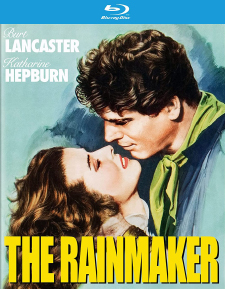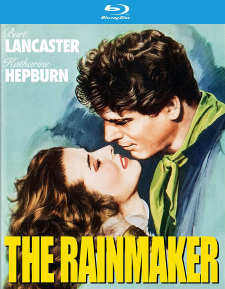Rainmaker, The (1956) (Blu-ray Review)

Director
Joseph AnthonyRelease Date(s)
1956 (October 25, 2022)Studio(s)
Paramount Pictures (Kino Lorber Studio Classics)- Film/Program Grade: B+
- Video Grade: A
- Audio Grade: A
- Extras Grade: B
Review
Pairing two stars in a film has always had the potential to draw audiences and accumulate bucks at the box office. The Rainmaker teamed Katharine Hepburn (The Lion in Winter) and Burt Lancaster (Elmer Gantry), who brought the characters of a spinster and a huckster, respectively, to larger-than-life proportions.
The film, adapted from the stage play by N. Richard Nash, opens with traveling conman Starbuck (Lancaster) atop his eye-catching wagon, ballyhooing and offering for sale his tornado warning devices—impressive-looking but useless contraptions—to the assembled townsfolk. After narrowly escaping arrest, he moves on to a town in Kansas that happens to be suffering a terrible drought.
Here we meet the Curry family—father H.C. Curry (Cameron Prud’Homme, Back from Eternity), elder son Noah (Lloyd Bridges, High Noon), younger son Jim (Earl Holliman, Forbidden Planet), and spinster daughter Lizzy (Hepburn). Lizzy has just returned to the family ranch from a visit to relatives in hopes of getting a husband, to no avail. This is of concern to the Curry men, who feel it’s way beyond the time that Lizzy should be married. Deputy sheriff J.S. File (Wendell Corey, Rear Window) likes Lizzy but claims to prefer life as a bachelor.
Starbuck encounters the Curry men riding their horses amid carcasses of steer that fell victim to the drought and announces that, for a fee, he can bring rain. Initially skeptical, H.C. feels they have nothing to lose but a hundred bucks and engages Starbuck despite continued skepticism by the pragmatic Noah and especially Lizzy, who sizes up the fast-talking Starbuck as a flim-flam man.
The presence of wild-eyed Starbuck in the Currys’ lives has unexpected results and he works particular magic with Lizzy, convincing her to see herself beyond her reflection in the mirror. He speaks to her in a manner that builds her self-confidence and opens a door to a future that she never thought possible for herself.
Burt Lancaster is perfect as Starbuck. With a mile-wide smile, flamboyant mannerisms, cocky self-assurance, and an ability to shift gears to reveal sensitivity, he brings more than rain to the emotional drought of the Curry household. Lancaster’s delivery projects cheerful self-confidence with a spontaneity and naturalness that allows him to inhabit the character of a con man with undeniable charm. At one point, Lancaster’s Starbuck disappears from the film for a long time, and he is missed.
Hepburn, who was in her late forties at the time and chronologically too old to play Lizzy, nonetheless delivers a splendid performance of an intelligent woman, the only female in an otherwise all-male household, despairing of ever being loved. Lizzy has a sense of humor, cheerily does household chores, speaks her mind, and accepts that spinsterhood is inevitable. She is visibly hurt but her lack of self-pity shows strength and resolve. Hepburn conveys resignation and acceptance of Lizzy’s lot in life until Starbuck enters the picture. Her speech then picks up on Starbuck’s encouraging words and she acts more feminine and vulnerable to his charm, her delivery softer and more introspective. The Hepburn mannerisms have been restrained so that we get a solid, non-stereotypical portrayal of a plain but inwardly beautiful soul.
Holliman provides much of the film’s humor as naive Jim Curry, who is also affected by Starbuck’s influence. Always mobile, as if sitting or standing still for any length of time would freeze him in place, he conveys impatient youth, particularly in his awkward flirtations with Snookie Maguire (Yvonne Lime).
Director Joseph Anthony, along with Nash who wrote the screenplay based on his own play, have kept the story pretty much the same as it was on the New York stage. The major flaw of the film is its stinginess with exteriors. The plot hinges on a terrible drought but, apart from glistening faces of the men and the dead cattle, there’s little to illustrate the oppressive heat and dire need for water. One scene early in the film does show a wide expanse of vegetation-free land, but the majority takes place in or immediately outside the Curry ranch house, all shot on sound stages.
The dialogue is colorful and often amusing, but there are lengthy soliloquies more suited to the stage. Yet the film offers a nice showcase for Hepburn and Lancaster. Their roles are meaty and allow each actor to convey a nice range. Lancaster’s is the showier role and he runs with it. The film both opens and closes with him, and reflects a man who has himself changed during his stopover at the Curry ranch.
The Rainmaker was shot by director of photography Charles Lang on 35 mm film using Mitchell VistaVision cameras, finished photochemically, and released in the aspect ratio of 1.85:1. Kino Lorber’s Blu-ray presentation comes from a new 6K scan of the original 35 mm VistaVision camera negative, which was performed by Paramount Pictures. Overall, this is a beautiful looking film. The Technicolor is vibrant and rich, with flesh tones especially well reproduced, which help to compensate for the otherwise stagey look. The outside of the Curry ranch house is clearly an elaborate set on a sound stage. The one real exterior is expansive and shows barren, dry land as far as the eye can see, scattered with carcasses of dehydrated steer.
The soundtrack is English 2.0 mono DTS-HD Master Audio. Dialogue is clear and distinct throughout. There’s an echo-y quality in scenes set outdoors that are actually interior sets. Jimmy pounds a big bass drum repeatedly for his assigned part in helping to bring on rain. Horses’ hooves are heard as Starbuck drives his wagon and the Curry men ride their horses. When Starbuck pitches his tornado warning devices, we hear crowd chatter. The sound of a downpour is mixed with dialogue in a climactic scene.
Bonus materials include the following:
- Audio Commentary by Julie Kirgo
- Trailer (2:21)
- Elmer Gantry Trailer (3:18)
- The Lion in Winter Trailer (3:18)
- The Tarnished Angels Trailer (2:41)
- Lonelyhearts Trailer (2:20)
Commentator, film historian, and writer Julie Kirgo notes that The Rainmaker was based on a play by N. Richard Nash that started out as a TV broadcast. It’s also considered Nash’s best work. Hal Wallis had a contract with Burt Lancaster, who was the first actor to set up a company to produce its own films. Initially, Wallis wanted William Holden to play Starbuck. The time period is never made clear, but it appears to be the early part of the Great Depression. The film is a metaphor about individuals who find their true selves. Career overviews of the main actors are provided. Earl Holliman said that his favorite role was Jim Curry. Cameron Prud’Homme was the only cast member who had appeared in the Broadway play. Hepburn and Lancaster approached their roles differently. Hepburn thoroughly prepared while Lancaster preferred to learn his lines the day of filming to maintain spontaneity. The sole remote location was in the Utah desert. Director Joseph Anthony found Lancaster grouchy and Lancaster felt Anthony couldn’t open up the play cinematically. The film seems to say that “the male gaze legitimizes a woman’s beauty,” a theme that’s out of touch with contemporary thinking. Starbuck has helped Lizzy and Jim. Lizzy has been seen for her own uniqueness. The rain at the end The Rainmaker and the boys’ band playing perfectly in The Music Man both indicate an extension of the films’ respective fables about charismatic con men.
Katharine Hepburn infuses Lizzy with vulnerability while Burt Lancaster draws upon his impressive physical presence, creating a Starbuck that seems a whirlwind force of nature. These two complete opposites are thrown together as a result of a con that turns out to be far more. The Rainmaker metaphorically deals with a woman who’s emotionally drought-ridden in her world until a con man steps in, upsetting the equilibrium and challenging her self-image. Though set in the West, the film is not the standard Western. It remains true to genre conventions but avoids shoot-em-ups and bar fights in favor of drama and humor.
- Dennis Seuling

